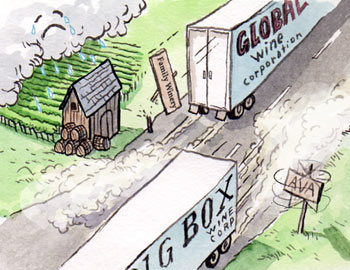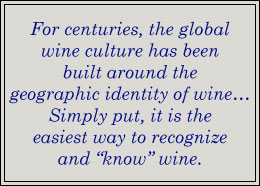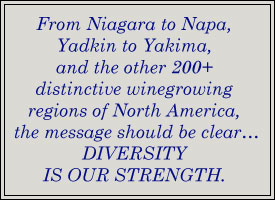

Why Build Appellation Consciousness?
An open letter from the Publisher
Appellation America Publisher, Roger Dial, addresses the threat posed to North America’s diverse winegrowing regions by the mass production and mass marketing dynamics of the contemporary economy and culture.
by
Roger Dial
August 31, 2006
Wine By Place Names
For centuries, the global wine culture has been built around the geographic identity of wine. People the world over know wine by its place of origin. The genesis of this ancient practice is both obscure and complex, but the continuing value of geographically structured consciousness to the wine culture and marketplace is not difficult to understand. Simply put, it is the easiest way to recognize and “know” wine.
 Consciousness of place is perhaps the most basic and natural human learning process. Place consciousness is fundamental to human psychological security, beginning with the four year old child who expands his perimeter of safe activity by increments of spatial awareness. In much the same way, a forty year old adult will expand his lifestyle by gravitating to familiar place names in a sea of confusing, and often meaningless, product names. Humans have an inherent tendency to go where we have place security, and place identity is always a powerful invitation for our timid species to venture forth…to explore!
Consciousness of place is perhaps the most basic and natural human learning process. Place consciousness is fundamental to human psychological security, beginning with the four year old child who expands his perimeter of safe activity by increments of spatial awareness. In much the same way, a forty year old adult will expand his lifestyle by gravitating to familiar place names in a sea of confusing, and often meaningless, product names. Humans have an inherent tendency to go where we have place security, and place identity is always a powerful invitation for our timid species to venture forth…to explore!
Consider that the whole travel industry is built on this calculus: give a particular place a distinct identity, and people will feel secure enough to go there. Not surprisingly, the wine culture is full of travel metaphors. In fact, the travel industry business model could not be more pertinent to the North American wine industry in its current stage of development. Exploration = Growth in the Market!
Wine by Winery and Varietal Names
In contrast to the almost primal naturalness of place identification, the North American wine culture over the past four decades has been structured largely around individual winery brand identity and varietal identity. Ironically, in the preceding generations, North American wine identity was grafted onto European place identity, leading to designations such as California “Chablis”, New York “Champagne” or Canadian “Rhinewine”. Of course, in this hybrid form, the euro-identities were meaningless and bogus, a situation which eventually led to distrust. The lesson for the future is clear: place identity needs to be constructed out of real descriptors in order to build meaningful and compelling familiarity.
 To be sure, winery brand identity and varietal identity each have their utilities in building-out the North American wine culture. For vineyard based wineries (as distinct from mass market focused branding enterprises), winery brand identity was most effective in the “pioneering” decades of the 70s and 80s, when the arrival of a new winery on the scene was, in itself, a compelling story-identity for consumers to build their consciousness around. But in the more recent arena of 4000+ North American wineries and many times that number of brand names (not counting global label-identity competition), individual winery brand identity is not much of a sign post, less still a safety blanket to encourage consumer exploration. Similarly, varietal identity worked for a time to give consumers a “consciousness hook” to hang their interest and decisions on. But what expectations can today's consumers have in a choice matrix of thousands of Chardonnays, multiplied by thousands of winery and mass market brand names?
To be sure, winery brand identity and varietal identity each have their utilities in building-out the North American wine culture. For vineyard based wineries (as distinct from mass market focused branding enterprises), winery brand identity was most effective in the “pioneering” decades of the 70s and 80s, when the arrival of a new winery on the scene was, in itself, a compelling story-identity for consumers to build their consciousness around. But in the more recent arena of 4000+ North American wineries and many times that number of brand names (not counting global label-identity competition), individual winery brand identity is not much of a sign post, less still a safety blanket to encourage consumer exploration. Similarly, varietal identity worked for a time to give consumers a “consciousness hook” to hang their interest and decisions on. But what expectations can today's consumers have in a choice matrix of thousands of Chardonnays, multiplied by thousands of winery and mass market brand names?
Building Appellation Consciousness
Appellation consciousness (that is to say, place-of-origin-identity) is the missing ingredient in the future health of the vineyard-based North American wine industry and culture. To its credit, the industry has come a long way in the past couple of decades in creating the building blocks of appellation identity. Designation and certification of American Viticultural Areas (AVAs) in the United States and Designated Viticultural Areas (DVAs) in Canada has been, and continues to be, the necessary first step in shifting the North American wine culture to the kind of appellation-focused paradigm that will greatly broaden interest and expand markets.
Place identity will not replace winery brand and varietal identity, but rather aggregate and enhance those identities in a geographic framework of consciousness that is natural and unstudied in the intellectual “mapping” process of the human mind. Place identity will ease the insecurity of entry-level wine consumers, as well as expand the horizons of ever-searching wine explorers.
Building REAL Place Identity
Place identity gives a comforting sense of meaning to objects and commodities. But that begs the question: what gives “meaning” to place identity? Real meaning, that is, as distinct from airy clichés and promotional hype? Sadly, the current place-recognition value of most AVAs, from the oldest (Augusta-1980) to the newest (Eola-Amity Hills-2006), is virtually nil, even in the minds of dedicated wine enthusiasts. Furthermore, much remains to be done within the professional communities of each appellation to crystallize descriptors (terroir, micro-climes, varietal & clonal mapping, local culture, distinct historical development, etc) that will give substance to distinctive place identities in order to provide lasting traction in the expanding marketplace.
Furthermore, much remains to be done within the professional communities of each appellation to crystallize descriptors (terroir, micro-climes, varietal & clonal mapping, local culture, distinct historical development, etc) that will give substance to distinctive place identities in order to provide lasting traction in the expanding marketplace.
This, then, is Appellation America's mission: to work with the industry professionals in each and every North American appellation to facilitate place-identity definition, and then to build appellation consciousness in the broader public. From Niagara to Napa, Yadkin to Yakima, and the other 200+ distinctive winegrowing regions of North America, the message should be clear…DIVERSITY IS OUR STRENGTH.
~ Roger Dial, Publisher
To comment on Roger Dial’s writings and thoughts, contact him at r.dial@appellationamerica.com
For centuries, the global wine culture has been built around the geographic identity of wine. People the world over know wine by its place of origin. The genesis of this ancient practice is both obscure and complex, but the continuing value of geographically structured consciousness to the wine culture and marketplace is not difficult to understand. Simply put, it is the easiest way to recognize and “know” wine.
 Consciousness of place is perhaps the most basic and natural human learning process. Place consciousness is fundamental to human psychological security, beginning with the four year old child who expands his perimeter of safe activity by increments of spatial awareness. In much the same way, a forty year old adult will expand his lifestyle by gravitating to familiar place names in a sea of confusing, and often meaningless, product names. Humans have an inherent tendency to go where we have place security, and place identity is always a powerful invitation for our timid species to venture forth…to explore!
Consciousness of place is perhaps the most basic and natural human learning process. Place consciousness is fundamental to human psychological security, beginning with the four year old child who expands his perimeter of safe activity by increments of spatial awareness. In much the same way, a forty year old adult will expand his lifestyle by gravitating to familiar place names in a sea of confusing, and often meaningless, product names. Humans have an inherent tendency to go where we have place security, and place identity is always a powerful invitation for our timid species to venture forth…to explore! Consider that the whole travel industry is built on this calculus: give a particular place a distinct identity, and people will feel secure enough to go there. Not surprisingly, the wine culture is full of travel metaphors. In fact, the travel industry business model could not be more pertinent to the North American wine industry in its current stage of development. Exploration = Growth in the Market!
Wine by Winery and Varietal Names
In contrast to the almost primal naturalness of place identification, the North American wine culture over the past four decades has been structured largely around individual winery brand identity and varietal identity. Ironically, in the preceding generations, North American wine identity was grafted onto European place identity, leading to designations such as California “Chablis”, New York “Champagne” or Canadian “Rhinewine”. Of course, in this hybrid form, the euro-identities were meaningless and bogus, a situation which eventually led to distrust. The lesson for the future is clear: place identity needs to be constructed out of real descriptors in order to build meaningful and compelling familiarity.
 To be sure, winery brand identity and varietal identity each have their utilities in building-out the North American wine culture. For vineyard based wineries (as distinct from mass market focused branding enterprises), winery brand identity was most effective in the “pioneering” decades of the 70s and 80s, when the arrival of a new winery on the scene was, in itself, a compelling story-identity for consumers to build their consciousness around. But in the more recent arena of 4000+ North American wineries and many times that number of brand names (not counting global label-identity competition), individual winery brand identity is not much of a sign post, less still a safety blanket to encourage consumer exploration. Similarly, varietal identity worked for a time to give consumers a “consciousness hook” to hang their interest and decisions on. But what expectations can today's consumers have in a choice matrix of thousands of Chardonnays, multiplied by thousands of winery and mass market brand names?
To be sure, winery brand identity and varietal identity each have their utilities in building-out the North American wine culture. For vineyard based wineries (as distinct from mass market focused branding enterprises), winery brand identity was most effective in the “pioneering” decades of the 70s and 80s, when the arrival of a new winery on the scene was, in itself, a compelling story-identity for consumers to build their consciousness around. But in the more recent arena of 4000+ North American wineries and many times that number of brand names (not counting global label-identity competition), individual winery brand identity is not much of a sign post, less still a safety blanket to encourage consumer exploration. Similarly, varietal identity worked for a time to give consumers a “consciousness hook” to hang their interest and decisions on. But what expectations can today's consumers have in a choice matrix of thousands of Chardonnays, multiplied by thousands of winery and mass market brand names? Building Appellation Consciousness
Appellation consciousness (that is to say, place-of-origin-identity) is the missing ingredient in the future health of the vineyard-based North American wine industry and culture. To its credit, the industry has come a long way in the past couple of decades in creating the building blocks of appellation identity. Designation and certification of American Viticultural Areas (AVAs) in the United States and Designated Viticultural Areas (DVAs) in Canada has been, and continues to be, the necessary first step in shifting the North American wine culture to the kind of appellation-focused paradigm that will greatly broaden interest and expand markets.
Place identity will not replace winery brand and varietal identity, but rather aggregate and enhance those identities in a geographic framework of consciousness that is natural and unstudied in the intellectual “mapping” process of the human mind. Place identity will ease the insecurity of entry-level wine consumers, as well as expand the horizons of ever-searching wine explorers.
Building REAL Place Identity
Place identity gives a comforting sense of meaning to objects and commodities. But that begs the question: what gives “meaning” to place identity? Real meaning, that is, as distinct from airy clichés and promotional hype? Sadly, the current place-recognition value of most AVAs, from the oldest (Augusta-1980) to the newest (Eola-Amity Hills-2006), is virtually nil, even in the minds of dedicated wine enthusiasts.
 Furthermore, much remains to be done within the professional communities of each appellation to crystallize descriptors (terroir, micro-climes, varietal & clonal mapping, local culture, distinct historical development, etc) that will give substance to distinctive place identities in order to provide lasting traction in the expanding marketplace.
Furthermore, much remains to be done within the professional communities of each appellation to crystallize descriptors (terroir, micro-climes, varietal & clonal mapping, local culture, distinct historical development, etc) that will give substance to distinctive place identities in order to provide lasting traction in the expanding marketplace. This, then, is Appellation America's mission: to work with the industry professionals in each and every North American appellation to facilitate place-identity definition, and then to build appellation consciousness in the broader public. From Niagara to Napa, Yadkin to Yakima, and the other 200+ distinctive winegrowing regions of North America, the message should be clear…DIVERSITY IS OUR STRENGTH.
~ Roger Dial, Publisher
To comment on Roger Dial’s writings and thoughts, contact him at r.dial@appellationamerica.com














